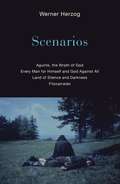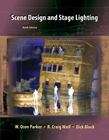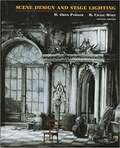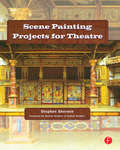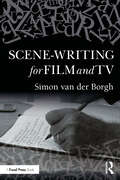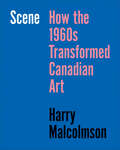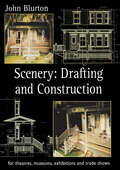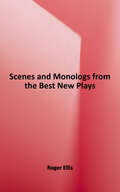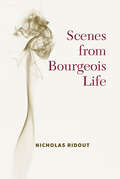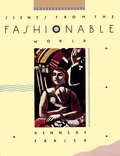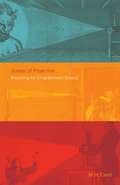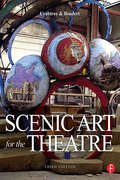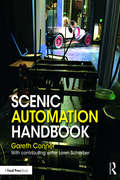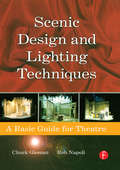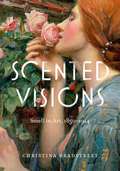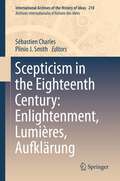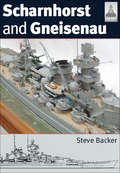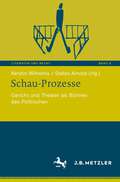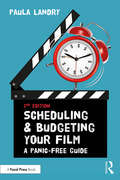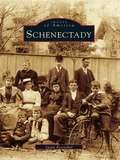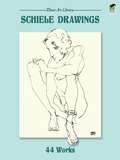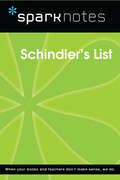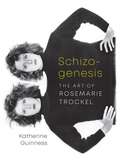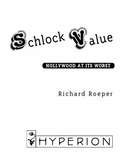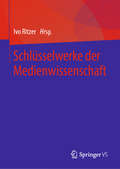- Table View
- List View
Scenarios: Aguirre, the Wrath of God; Every Man for Himself and God Against All; Land of Silence and Darkness; Fitzcarraldo
by Werner HerzogI do not follow ideas, I stumble into stories or into people; and I know that this is so big, I have to make a film. Very often, films come like uninvited guests, like burglars in the middle of the night. They are in your kitchen; something is stirring, you wake up at 3 a.m. and all of a sudden they come wildly swinging at you.When I write a screenplay, I write it as if I have the whole film in front of my eyes. Then it is very easy for me, and I can write very, very fast. It is almost like copying. But of course sometimes I push myself; I read myself into a frenzy of poetry, reading Chinese poets of the eighth and ninth century, reading old Icelandic poetry, reading some of the finest German poets like Hölderlin. All of this has absolutely nothing to do with the idea of my film, but I work myself up into this kind of frenzy of high-caliber language and concepts and beauty.And then sometimes I push myself by playing music, for example, a piano concerto by Beethoven, and I play it and write furiously. But none of this is an answer to the question of how you focus on a single idea for a film. And then, during shooting, you have to depart from it sometimes, while keeping it alive in its essence. —Werner Herzog, on filmmakingWerner Herzog doesn&’t write traditional screenplays. He writes fever dreams brimming with madness, greed, humor, and dark isolation that can shift dramatically during production—and have materialized into extraordinary masterpieces unlike anything in film today. Harnessing his vision and transcendent reality, these four pieces of long-form prose earmark a renowned filmmaker at the dawn of his career.
Scene Design and Stage Lighting
by W. Oren Parker R. Craig Wolf Dick BlockPacked with professional information and cutting-edge technologies, SCENE DESIGN AND STAGE LIGHTING, Ninth Edition, equips you with the most up-to-date coverage available on scenery, lighting, sound, and technology. Completely current, the exciting new ninth edition mirrors the best of real-world practices. Vibrant color production photographs support the text and spotlight examples of contemporary work. Scenery design and technology coverage includes a strong emphasis on modern technology, while changes in the lighting section reflect the latest practices. Coverage of sound for the theatre reflects the digital age in which we live and work. The text also includes an expanded section on television design, as well as greater emphasis on health and safety issues. The authors emphasize collaboration in all sections of the new text, and they provide insight via interviews with professional lighting and scenery designers in two features: "Working Professionals" and "Designers at Work. " Reflecting current professional practice, SCENE DESIGN AND STAGE LIGHTING, Ninth Edition, offers in-depth coverage of a broad range of topics, making it the most detailed and comprehensive text available in the scenic and lighting design and technology fields.
Scene Design and Stage Lighting
by W. Oren Parker R. Craig WolfThis established and respected text for courses in scene design and stage lighting offers a contemporary viewpoint from two experienced authors. The authors highlight current trends, such as the importance of collaboration in the theatrical process.
Scene Painting Projects for Theatre
by Stephen G. SherwinThe art, practice, and technique of scene painting is an essential part of theatre design. A scenic artist is responsible for translating the vision of the scenic designer to the realized scenery.Unlike all other scene painting books, this text will take you step-by-step through actual individual scene painting projects. Each project is commonly used in theatrical productions and each project builds upon the skills learned in the previous lesson. From wood and marble, to foliage and drapery, this book will teach the you how to become a skilled scenic painter.
Scene-writing for Film and TV
by Simon van der BorghFocusing on an integral aspect of screenplays, this book takes students and writers at all levels through the process of understanding and writing better scenes. It interrogates the functions of a scene and how writers can then apply this knowledge to their own film and television scripts. Author Simon van der Borgh familiarises the screenwriter with the fundamental aspects of a scene, looking at what a scene is, the characters involved, the action depicted, dialogue, setting, and style. Featuring original scenes which show the practice of scene-writing and the application of ideas and approaches alongside in-depth analysis and critique, the book explores the process and approach to scene-writing and how to learn and improve methods of telling dynamic, engaging and moving stories of diverse types and formats on screen. With a strong focus on practice-based advice, the book includes exercises at every step to enable writers to build on and extend their knowledge and skills with confidence and clarity chapter by chapter. Exploring the film and TV scene with its different types, forms, and functions, it is the ideal book for aspiring screenwriters and students of screenwriting and filmmaking at all levels, as well as directors, producers and actors looking to better understand the contextual and sub-textual motivations intended by the writer.
Scene: How the 1960s Transformed Canadian Art
by Harry MalcolmsonThe 1960s transformed art in Canada. The Scene traces the remarkable reshaping of the Canadian art landscape during that era. Written by renowned art critic Harry Malcolmson, the book offers a captivating insider’s perspective on how a surge of artists, galleries, collectors, and critics propelled Canadian art into the global spotlight. Malcolmson identifies the catalysts that ignited this artistic renaissance, including an outpouring of pride in the country linked to Canada's Centennial, Expos ’67, and the Toronto City Hall. With rich anecdotes and insights, the book paints a comprehensive portrait of the era, while showcasing over twenty portraits of influential Canadian artists. Richly illustrated, the book illuminates the totality of the Scene’s evolution, and delves into the impact of Canadian nationalism and economic prosperity on the Scene. It examines the rise of contemporary institutions, such as the Art Gallery of Ontario and the National Gallery of Canada, capturing the emergence of a modern Canadian identity. Ultimately, The Scene stands as a unique testament to a pivotal moment in cultural history, capturing the essence of the most impactful decade in the history of art in Canada.
Scenery: Draughting and Construction for Theatres, Museums, Exhibitions and Trade Shows
by John BlurtonThis practical book looks at the types of drawing used, equipment, materials commonly specified, surveying, and also covers building floors, flats, cloths, windows, doors, trucks, staircases, roofs, revolves, multi-story structures, and bridges. By addressing both theater and the commercial world this book will be of real help to a broad range of people in the theater industry.
Scenes and Monologs from the Best New Plays: An Anthology of New Dramatic Writing from Professionally Produced American Plays
by Roger EllisThis book is a practical resource for acting and directing students of all ages middle through high school, college, and professionals young and old. Its 30 duet scenes and eight monologues include a fair sampling of the late 20th-century work of playwrights across the United States. These excerpts are highly original in that few people can claim to have read or seen them performed, though they have all been produced regionally. The gallery of characters contained in these pages offers readers an arresting and kaleidoscopic reflection of American society. The literary styles one encounters here demonstrate the range and power of American writers who will continue to shape theatrical techniques for years to come. Overall, this anthology provides a generous sampling of vital and compelling treatments of our social, artistic, and spiritual experiences of the late 20th century.
Scenes from Bourgeois Life (Theater: Theory/Text/Performance)
by Nicholas RidoutScenes from Bourgeois Life proposes that theatre spectatorship has made a significant contribution to the historical development of a distinctive bourgeois sensibility, characterized by the cultivation of distance. In Nicholas Ridout’s formulation, this distance is produced and maintained at two different scales. First is the distance of the colonial relation, not just in miles between Jamaica and London, but also the social, economic, and psychological distances involved in that relation. The second is the distance of spectatorship, not only of the modern theatregoer as consumer, but the larger and pervasive disposition to observe, comment, and sit in judgment, which becomes characteristic of the bourgeois relation to the rest of the world. This engagingly written study of history, class, and spectatorship offers compelling proof of “why theater matters,” and demonstrates the importance of examining the question historically.
Scenes from the Fashionable World
by Kennedy Fraser"These essays, reprinted from the New Yorker, evince the fastidious prose and finely tuned insights praised in Fraser's first book, The Fashionable Mind. Four pieces emphasize the competition and hype surrounding designers, models, photographers, advertising people, etc.; other articles observe the trendy international scene. Fraser exceeds herself in "As Gorgeous as It Gets," which describes, in glittering detail, cosmetician Estee Lauder and her retinue on travels to promote a new perfume at Nieman-Marcus in Dallas and Saks, Bloomingdale's and Macy's in New York City. This wonderful collection will amaze and amuse readers." --Publisher's Weekly
Scenes of Projection: Recasting the Enlightenment Subject
by Jill H. CasidTheorizing vision and power at the intersections of the histories of psychoanalysis, media, scientific method, and colonization, Scenes of Projection poaches the prized instruments at the heart of the so-called scientific revolution: the projecting telescope, camera obscura, magic lantern, solar microscope, and prism. From the beginnings of what is retrospectively enshrined as the origins of the Enlightenment and in the wake of colonization, the scene of projection has functioned as a contraption for creating a fantasy subject of discarnate vision for the exercise of &“reason.&” Jill H. Casid demonstrates across a range of sites that the scene of projection is neither a static diagram of power nor a fixed architecture but rather a pedagogical setup that operates as an influencing machine of persistent training. Thinking with queer and feminist art projects that take up old devices for casting an image to reorient this apparatus of power that produces its subject, Scenes of Projection offers a set of theses on the possibilities for felt embodiment out of the damaged and difficult pasts that haunt our present.
Scenic Art for the Theatre: History, Tools and Techniques
by Susan Crabtree Peter BeudertNow in its Third Edition, Scenic Art for the Theatre: History, Tools and Techniques continues to be the most trusted source for both student and professional scenic artists. With new information on scenic design using Photoshop, Paint Shop Pro and other digital imaging softwares this test expands to offer the developing artist more step-by-step instuction and more practical techniques for work in the field. It goes beyond detailing job functions and discussing techniques to serve as a trouble-shooting guide for the scenic artist, providing practical advice for everyday solutions.
Scenic Automation Handbook
by Gareth ConnerScenic automation has earned a reputation of being complicated and cantankerous, a craft best left to the elite of our industry. Not sure of the difference between a VFD, PLC, or PID? If you have dreamed of choreographing scene changes with computerized machinery, but get lost in the technical jargon the Scenic Automation Handbook will guide you along the road to elegant automation. Adopting a pragmatic approach, this book breaks down any automation system into five points, known as the Pentagon of Power. Breaking down a dauntingly complex system into bite- size pieces makes it easy to understand how components function, connect, and communicate to form a complete system. Presenting the fundamental behaviors and functions of Machinery, Feedback Sensors, Amplifiers, Controls, and Operator Interfaces, the Scenic Automation Handbook demystifies automation, reinforcing each concept with practical examples that can be used for experimentation. Automation is accessible – come along and learn how!
Scenic Design and Lighting Techniques: A Basic Guide for Theatre
by Rob Napoli Chuck GlomanBasic. This is the key word in Scenic Design and Lighting Tecniques: A Basic Guide for Theatre, written by two seasoned professionals with over twenty years of experience. This book is designed to show you how to turn a bare stage into a basic set design, without using heavy language that would bog you down. From materials and construction to basic props and lighting, this book explains all you will need to know to build your set and light it.
Scented Visions: Smell in Art, 1850-1914 (Perspectives on Sensory History)
by Christina BradstreetSmell loomed large in cultural discourse in the late nineteenth century, thanks to the midcentury fear of miasma, the drive for sanitation reform, and the rise in artificial perfumery. Meanwhile, the science of olfaction remained largely mysterious, prompting an impulse to “see smell” and inspiring some artists to picture scent in order to better know and control it. This book recovers the substantive role of the olfactory in Pre-Raphaelite art and Aestheticism.Christina Bradstreet examines the iconography and symbolism of scent in nineteenth-century art and visual culture. Fragrant imagery in the work of John Everett Millais, Dante Gabriel Rossetti, Simeon Solomon, George Frederic Watts, Edward Burne-Jones, and others set the trend for the preoccupation with scent that informed swaths of British, European, and American art and design. Bradstreet’s rich analyses of paintings, perfume posters, and other works of visual culture demonstrate how artworks mirrored the “period nose” and intersected with the most clamorous debates of the day, including evolution, civilization, race, urban morality, mental health, faith, and the “woman question.”Beautifully illustrated and grounded in current practices in sensory history, Scented Visions presents both fresh readings of major works of art and a deeper understanding of the cultural history of nineteenth-century scent.
Scepticism in the Eighteenth Century: Enlightenment, Lumières, Aufklärung
by Sébastien Charles Plínio J. SmithThe Age of Enlightenment has often been portrayed as a dogmatic period on account of the veritable worship of reason and progress that characterized Eighteenth Century thinkers. Even today the philosophes are considered to have been completely dominated in their thinking by an optimism that leads to dogmatism and ultimately rationalism. However, on closer inspection, such a conception seems untenable, not only after careful study of the impact of scepticism on numerous intellectual domains in the period, but also as a result of a better understanding of the character of the Enlightenment. As Giorgio Tonelli has rightly observed: "the Enlightenment was indeed the Age of Reason but one of the main tasks assigned to reason in that age was to set its own boundaries." Thus, given the growing number of works devoted to the scepticism of Enlightenment thinkers, historians of philosophy have become increasingly aware of the role played by scepticism in the Eighteenth Century, even in those places once thought to be most given to dogmatism, especially Germany. Nevertheless, the deficiencies of current studies of Enlightenment scepticism are undeniable. In taking up this question in particular, the present volume, which is entirely devoted to the scepticism of the Enlightenment in both its historical and geographical dimensions, seeks to provide readers with a revaluation of the alleged decline of scepticism. At the same time it attempts to resituate the Pyrrhonian heritage within its larger context and to recapture the fundamental issues at stake. The aim is to construct an alternative conception of Enlightenment philosophy, by means of philosophical modernity itself, whose initial stages can be found herein.
Scharnhorst and Gneisenau: Shipcraft 20 (ShipCraft #20)
by Steve BackerA history of the service careers and advice on making models of &“perhaps the most successful of the German battleships of the Second World War&” (History of War). The ShipCraft series provides in-depth information about building and modifying model kits of famous warship types. Lavishly illustrated, each book takes the modeler through a brief history of the subject class, highlighting differences between sister-ships and changes in their appearance over their careers This includes paint schemes and camouflage, featuring color profiles and highly-detailed line drawings and scale planes. The modeling section reviews the strengths and weaknesses of available kits, lists commercial accessory sets for super-detailing of the ships, and provides hints on modifying and improving the basic kit. This is followed by an extensive photographic gallery of selected high-quality models in a variety of scales, and the book concludes with a section on research reference books, monographs, large-scale plans and relevant websites. The two German ships which form the subject of this volume were among the first products of rearmament under Hitler. For political reasons they were neither as large nor as well armed as foreign equivalents, but they were very fast, which led them to be described as battlecruisers in some quarters. They enjoyed an adventurous war, both surviving heavy damage, before Scharnhorst was sunk in an epic gun battle off the North Cape, while Gneisenau succumbed to heavy air attack.&“For both vessels, the book gives details of modifications carried out, while a wealth of clear and detailed photographs and line drawings illustrate the ships themselves, as well as items of equipment.&” —Ships Monthly
Schau-Prozesse: Gericht und Theater als Bühnen des Politischen (Literatur und Recht #8)
by Stefan Arnold Kerstin WilhelmsGerichtsprozesse wie der NSU-Prozess haben große mediale Aufmerksamkeit erfahren und sind zum Stoff von zahlreichen Theaterinszenierungen geworden. Solche publikumswirksamen ‚Schau-Prozesse‘ zeigen, wie Gericht und Theater zu Bühnen des Politischen werden. Dabei wird deutlich, dass Recht und Theater viel fundamentaler verbunden sind, als bislang diskutiert: Sie konstituieren sich gegenseitig. Theatrale Elemente sind für das Recht unverzichtbar und umgekehrt prägen Rechtsinszenierungen das Theater. Die Beiträge des interdisziplinären Bandes analysieren diese Wechselseitigkeit und fokussieren die politische Performance im Theater und im Recht.
Scheduling and Budgeting Your Film: A Panic-Free Guide (American Film Market Presents)
by Paula LandryBudgeting and scheduling are easy in principle but hard in practice. The successful producer has a solid plan for juggling dozens of activities and costs while retaining the flexibility to cope with those inevitable last-minute changes and stay on course. Preplanning the budget and schedule of any media project is absolutely essential, and the 2nd edition of Scheduling and Budgeting Your Film: A Panic-Free Guide shows you the intricacies of handling both budgeting and scheduling successfully. This new and updated edition explains the fundamentals of line producing in an easy-to-understand style, and includes tips and techniques that apply no matter what kind of scheduling or budgeting software you’re using. Author Paula Landry includes detailed examples of breakdown forms, organizing resources, distribution expenses, and hidden costs, and discusses how to set realistic priorities and find industry and state tax incentives. The new edition also includes discussions of transmedia and multi-purpose shooting, special considerations for VR, 4K and 3D shooting, new web platforms and mobile technology, crowd funding, film festivals, and much more. Each chapter is filled with handy checklists, tips, practical advice, and anecdotes, showing how scheduling and budgeting are done in the real world; Principles apply to any type of media project: film, video, music video, projects hosted online, and corporate and educational videos; An accompanying eResources page offers downloadable forms and templates, and other essential resources.
Schenectady
by Susan RosenthalMidway between New York City and Montreal lies Schenectady, an area that first developed as an outpost to the fur trade and for agriculture. Schenectady's future growth was assured by its location on two major water routes, the Mohawk River and the Erie Canal. Schenectady survived the massacre of 1690 and was chartered as a city in 1798, becoming only the third city in the state. At the time of the charter, Schenectady was 12 miles long by 18 miles wide. The city saw astounding growth during the industrial age which brought not only a flood of new enterprises and commerce but also elegant homes, cobblestone streets, gaslights, and trolley cars. Schenectady also contributed to the development of the nation: the Monitor's turret, M7 tanks, and World War II radio and radar equipment were produced here.
Schiele Drawings: 44 Works
by Egon SchieleOne of the most famous Expressionist artists of early-20th-century Vienna, Egon Schiele (1890-1918) evolved a highly personal art, strongly influenced by Art Nouveau. Focusing on the emotional state and hidden personality of his subjects, Schiele produced works that are not only models of psychological penetration but evidence of great technical mastery as well, notably in their impeccable line and superb composition.This volume contains 44 of his finest drawings: portraits, character studies, nudes, and more, all embodying the distinctive, angular expressivity that characterizes Schiele's art. Now these superb works are available in this inexpensive format, painstakingly reproduced to capture every nuance of line, shading, positions, and expression.
Schindler's List (SparkNotes Film Guide)
by SparkNotesSchindler's List (SparkNotes Film Guide) Making the reading experience fun! SparkNotes Film Guides are one-stop guides to great works of film–masterpieces that are the foundations of filmmaking and film studies. Inside each guide you&’ll find thorough, insightful overviews of films from a variety of genres, styles, and time periods. Each film guide contains:Information about the director and the context in which the film was made Thoughtful analysis of major characters Details about themes, motifs, and symbols Explanations of the most important lines of dialogue In-depth discussions about what makes a film so remarkable SparkNotes Film Guides are an invaluable resource for students or anyone who wants to gain a deeper understanding of the great films they know and love.
Schizogenesis: The Art of Rosemarie Trockel
by Katherine GuinnessA deep analysis of an enigmatic artist whose oeuvre opens new spaces for understanding feminism, the body, and identity Popular and pioneering as a conceptual artist, Rosemarie Trockel has never before been examined at length in a dedicated book. This volume fills that gap while articulating a new interpretation of feminist theory and bodily identity based around the idea of schizogenesis central to Trockel&’s work.Schizogenesis is a fission-like form of asexual reproduction in which new organisms are created but no original is left behind. Author Katherine Guinness applies it in surprising and insightful ways to the career of an artist who has continually reimagined herself and her artistic vision. Drawing on the philosophies of feminists such as Simone de Beauvoir, Shulamith Firestone, and Monique Wittig, Guinness argues that Trockel&’s varied output of painting, fabric, sculpture, film, and performance is best seen as opening a space that is peculiarly feminist yet not contained by dominant articulations of feminism. Utilizing a wide range of historical and popular knowledge—from Baader Meinhof to Pinocchio, poodles, NASA, and Brecht—Katherine Guinness gives us the associative and ever-branching readings that Trockel&’s art requires. With a spirit for pursuing the surprising and the obscure, Guinness delves deep into a creator who is largely seen as an enigma, revealing Trockel as a thinker who challenges and transforms the possibilities of bodily representation and identity.
Schlock Value: Hollywood at Its Worst
by Richard RoeperA hilarious collection of essays, riffs, and lists that celebrate the insanity of Hollywood--for anyone who loves the movies. Richard Roeper, like the rest of us, adores the movies. In this uproarious, off-beat book, he gives us a whole new set of critical lenses for assessing the movies and the people and the industry that make them. With his characteristic acerbic wit, he weaves short essays with lists that work together to explain where Hollywood succeeds--and where it so often frustrates, disappoints, and fails us. But while Roeper devotes most of the book to mockery and ridicule, this book is, in the end, a love letter to film. Some of the essays and lists included in Schlock Value: Comical statistical breakdowns, including career batting averages of actors Reviews of Hollywood finances, including budgets, salaries, and ticket prices A proposed moratorium on pet projects, e.g., Kevin Costner's The Postman or John Travolta's Battlefield Earth The age differences between Woody Allen and his various leading ladies Actors appearing around the world in television commercials, including a list of the biggest stars that do overseas commercials--and the products they push Schlock Value is the perfect book for anyone who loves grumbling and complaining about the movies--but still can't help spending their weekends and evenings in front of the screen.
Schlüsselwerke der Medienwissenschaft
by Ivo RitzerDer Band stellt ausgewählte Positionen und zentrale Ideen im disziplinären Rahmen der Medienwissenschaft vor. Schwerpunkte liegen auf medienphilosophischen Ansätzen und einer kulturtheoretischen Perspektive, die sich vor einem dezidiert geisteswissenschaftlichen Horizont konturiert. Dabei versteht der Band sich nicht nur als Handbuch und Nachschlagewerk für Studierende wie Lehrende, er soll vielmehr auch einen eigenen Beitrag zur medienwissenschaftlichen Theoriebildung leisten.
